- This topic has 8 replies, 4 voices, and was last updated 9 years, 7 months ago by
 Bill Ward.
Bill Ward.
-
AuthorPosts
-
14 May 2016 at 9:59 pm #573569
 Bill WardParticipant
Bill WardParticipantHi,
Prior to the Mercury transit I’d not done any solar imagining for quite some time. It was noticing the granulation that gave me an idea. “Proper” narrow band Ca II filters have a very tight bandpass around 393nm. I happened to have a 390nm interference filter used for CN observations of comets. I wondered how it would perform on solar observing…
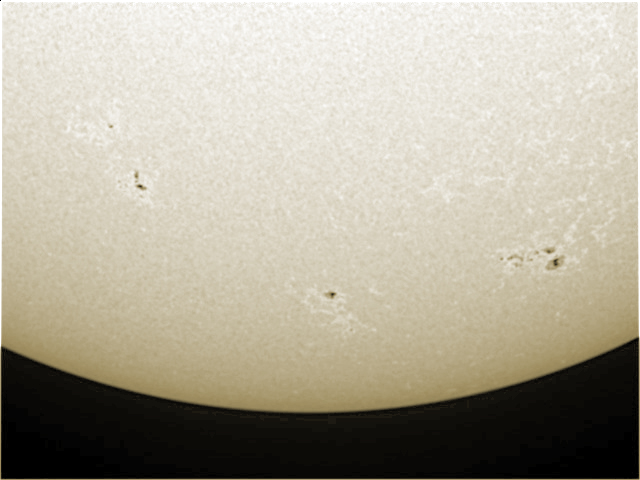
This is a stack of around 800 video frames (in really quite poor seeing) processed in registax 6 and stretched a little in photoshop. I’ve elected not to use what seems to be the trend of using a blue colouration though, after all the sun’s yellow 😉
The image was taken today, 2016 05 14 : 11 58ut, with an Image Source Camera on a Vixen FL102 f8.9 refractor plus a home made Baader Planterium film filter.
With the 10nm bandpass of the CN filter there isn’t the contrast cf a genuine Ca filter but it certainly seems to emphasise the faculae and granulation. Not too terrible…
cheers,
Bill.
Attachments:
15 May 2016 at 3:07 pm #577385 Bill WardParticipant
Bill WardParticipantAnother sunny day!
So another test session with the 390nm filter…
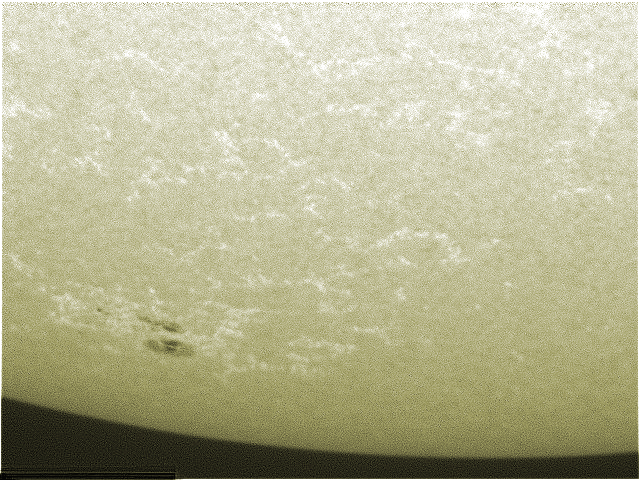
Gorgeous faculae. (Note image is of w limb but rotated by 90 degrees.)
and a nice big spot coming round the limb…
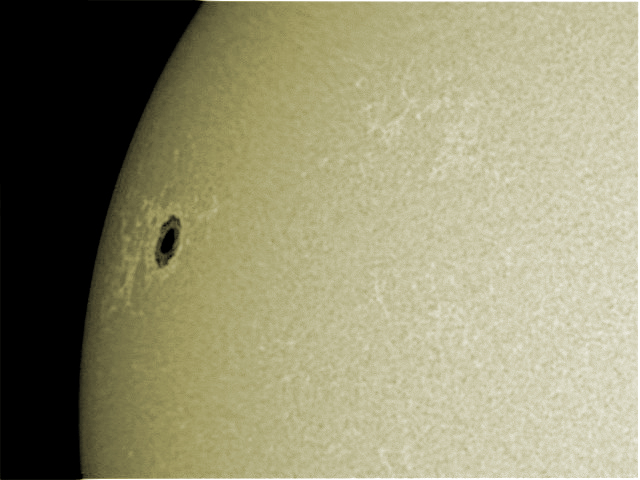
cheers,
Bill.
15 May 2016 at 8:34 pm #577386 Andy WilsonKeymaster
Andy WilsonKeymasterHi Bill,
Great idea to try out a narrow band filter with a full aperture white light filter. Your results look pretty good.
Andy
15 May 2016 at 10:13 pm #577387 Bill WardParticipant
Bill WardParticipantHi Andy,
Thanks, but its all in the image processing… 😉
I am quite please with how it’s performed though. Certainly planning on keeping it in place for a while.
The single spot image shows the Wilson effect quite nicely but I think I went a little overboard with the wavelet processing with the faculae image, it’s a bit “speckley”.
Although not as narrow as a proper Ca filter I am quite impressed that it can show the faculae well and possibly some of the super granulation of the chromospheric network.
It’s quite a paradox that I’ve got virtually nothing when I’ve actually tried it on the comets I’ve been able to see but it turns out to be great for solar observing!
cheers,
Bill.
21 May 2016 at 11:04 pm #577390 Bill WardParticipant
Bill WardParticipantHi,
The spot that I imaged on the limb a few days ago has turned out to be the classic sunspot…
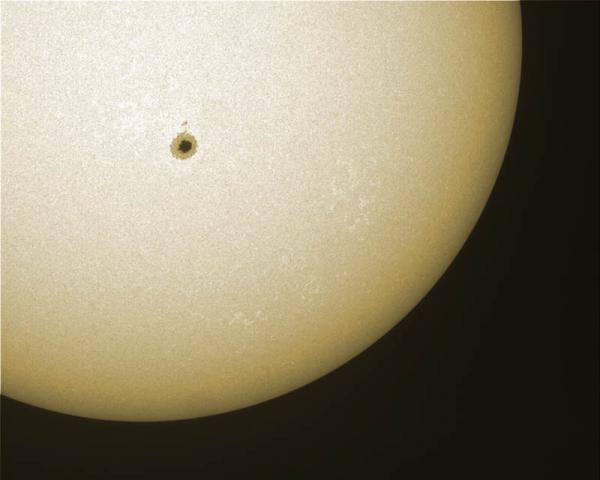
Image is a stack of 100 images processed in Registax 6. Taken 15.47UT today 21/5/16. Hopefully get a few more shots tomorrow if the weather cooperates.
A bit of pixel counting yields a spot diameter of around 47600km, ~3.7 times the diameter of the Earth.
… the Earth would sit nicely within the umbra!
Cheers,
Bill.
22 May 2016 at 2:51 am #577391 Bill WardParticipant
Bill WardParticipantHi,
A lot of books describe the limb darkening but I’ve never seen it actually plotted. So I thought it might be fun to see what it looks like. Since the images were taken through a deep blue filter the darkening should be more here than at longer wavelengths. Since the shorter wavelengths scatter more. (Might be interesting to try this as different wavelengths to see if the theory matches the observations…)
At the edge the value of pixels is 37.5% of the centre.
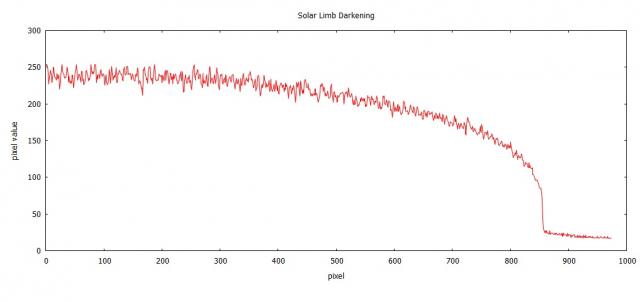
Fascinating!
cheers,
Bill.
23 May 2016 at 8:06 pm #577392 Paul Anthony BrierleyParticipant
Paul Anthony BrierleyParticipantHello Bill,
This is very interesting, and your pictures look very good indeed.
That spot “AR 2546” is very large and now visible without optical aid.
23 May 2016 at 9:27 pm #577393 Tim ParsonsParticipant
Tim ParsonsParticipantGreat pictures Bill. The one of AR2546 coming around the limb in particular looks wonderfully three-dimensional. Your brightness plot is interesting and, with the help of Messrs Stefan and Boltzmann (and the back of a convenient envelope!), suggests a temperature at the visible depth limit on the limb of just under 4540K, which is about what you would expect, given the usually quoted figure of 4400K for the top of the photosphere (as you suggest, the number is distorted a bit by the blue filter but the plot does suggest a temperature neatly in between that to be expected in the umbra and penumbra of the sunspot – it might be interesting to check against pixel values there too). Plotting across a range of wavelengths should indeed provide a more accurate result.
Cheers
Tim
23 May 2016 at 10:27 pm #577394 Bill WardParticipant
Bill WardParticipantHi,
I found a filter for 850nm (16nm fwhm) which happens to be very close to the emission wavelength of the Ca II IR triplet, however the image is much more bland at 850 due to less scattering and the fact that the telescope optics have less than half the resolution at this wavelength cf 390nm. (The Ca II IR triplet is used in spectrohelioscopes for photopolarimetry. The family of UV and IR transitions are quite interesting…)
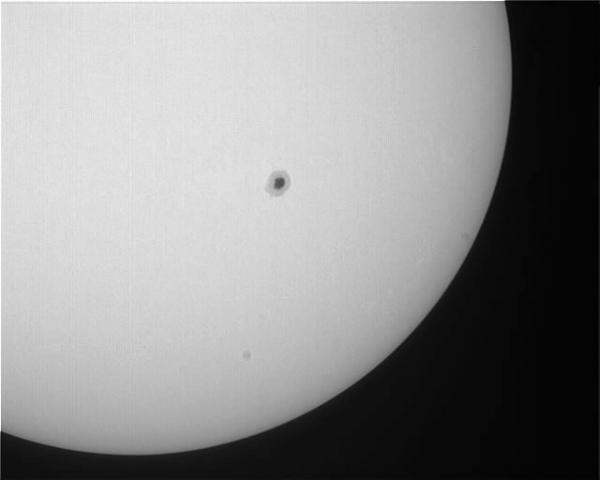
Even a casual inspection reveals the limb just looks brighter, so doing the very same thing as before gave this graph…
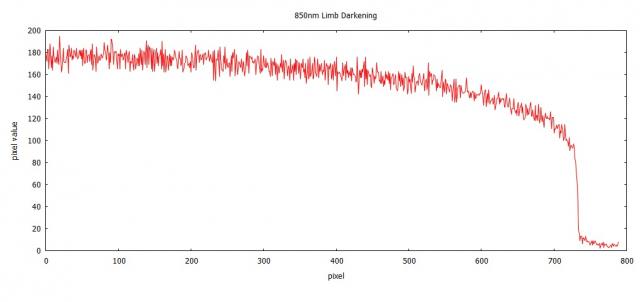
Which indeed does have a slightly less steep gradient than the 350nm image. The edge has a brightness of around 56% of the centre.
This was all done with “auto everything” on, with the camera and software so I’m not sure how absolutely accurate the measurements are photometrically but it makes sense, which is kinda re-assuring… 😉
On doing a bit more digging, this continues for some ways until the very shortest radio wave wavelengths are reached when there is a transition to limb brightening!
cheers,
Bill.
-
AuthorPosts
- You must be logged in to reply to this topic.
